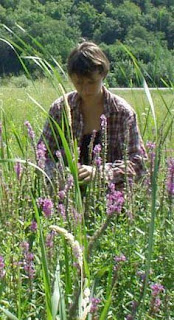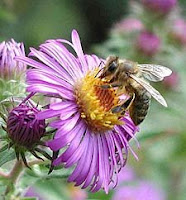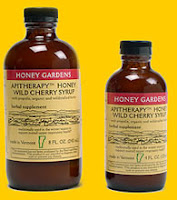Apitherapy propolis throat spray & wound wash with purple loosestrife & Usnea
 We never cease to be amazed in life when people and events come together synergistically, where their efforts and the resulting outcomes grow far beyond the potential accomplishments of a single individual. Our propolis, purple loosestrife, and Usnea wound wash, the newest product offered by the honey house, is not only the result of such synergistic human efforts, but its key ingredients are synergistic players as well. The herbs and propolis work beautifully together to promote tissue repair, heal fresh scar tissue, decrease inflammation and bleeding, stimulate local immune system functions, and act as an antibacterial, antifungal, anti-inflammatory, and antiviral agent. The astringent quality contributes its effectiveness as an antidiarrheal agent as well. In the language of wound healing, this is indeed broad spectrum coverage.
We never cease to be amazed in life when people and events come together synergistically, where their efforts and the resulting outcomes grow far beyond the potential accomplishments of a single individual. Our propolis, purple loosestrife, and Usnea wound wash, the newest product offered by the honey house, is not only the result of such synergistic human efforts, but its key ingredients are synergistic players as well. The herbs and propolis work beautifully together to promote tissue repair, heal fresh scar tissue, decrease inflammation and bleeding, stimulate local immune system functions, and act as an antibacterial, antifungal, anti-inflammatory, and antiviral agent. The astringent quality contributes its effectiveness as an antidiarrheal agent as well. In the language of wound healing, this is indeed broad spectrum coverage.
The arrival of our throat spray & wound wash to the marketplace at this time is indeed fortuitous. In this age of antibiotic resistance there needs to be a natural product that acts as a broad spectrum antibiotic and antiseptic (similar in nature to iodine and Betadine™). Propolis, raw honey, and Usnea are known individually to have strong antibiotic activity against gram-positive bacteria such as Streptococcus, Staphylococcus, and Pneumonococcus organisms. Combined in the same formula, propolis, raw honey, and Usnea with added purple loosestrife act synergistically to provide a unique natural coverage as a broad spectrum antibiotic and antiseptic. For people who cannot or choose not to take pharmaceutical antibiotics, throat spray & wound wash is a welcome solution.
Purple loosestrife (Lythrum salicaria),  the much-maligned-of-late, magenta flowered, aggressively growing wetlands perennial, is a key contributor to wound wash effectiveness. Originally introduced to the North American cut flower trade from Japan in the 1880s, perennial flower enthusiasts more recently have included it in their gardens because of its lovely spikes of purply-pink flowers. No one foresaw that purple loosestrife was a beauty who didn’t respect boundaries and as a result, she began replacing native plant wetland species. Our intention at the honey house is to take full advantage of the local abundance of purple loosestrife. We harvest it in a way that not only discourages its invasive spread into our wetland ecosystems, but also optimizes its contributions to the wound wash formula. Its wound healing properties as an antibacterial, astringent, emollient, anti-inflammatory, and antihemorrhagic (styptic) agent combine nicely with those of the propolis and Usnea. In using purple loosestrife we are removing it from ecosystems where it doesn’t belong and at the same time creating a very effective wound wash, because of its synergistic effect with propolis and Usnea.
the much-maligned-of-late, magenta flowered, aggressively growing wetlands perennial, is a key contributor to wound wash effectiveness. Originally introduced to the North American cut flower trade from Japan in the 1880s, perennial flower enthusiasts more recently have included it in their gardens because of its lovely spikes of purply-pink flowers. No one foresaw that purple loosestrife was a beauty who didn’t respect boundaries and as a result, she began replacing native plant wetland species. Our intention at the honey house is to take full advantage of the local abundance of purple loosestrife. We harvest it in a way that not only discourages its invasive spread into our wetland ecosystems, but also optimizes its contributions to the wound wash formula. Its wound healing properties as an antibacterial, astringent, emollient, anti-inflammatory, and antihemorrhagic (styptic) agent combine nicely with those of the propolis and Usnea. In using purple loosestrife we are removing it from ecosystems where it doesn’t belong and at the same time creating a very effective wound wash, because of its synergistic effect with propolis and Usnea.
Though loosestrife threatens native aquatic vegetation, it provides an important pollen source for pollinators, particularly in times of drought, and is ranked close to goldenrod as a leading nectar producing plant. In an effort to constructively utilize this overabundant perennial, valued by many herbalists for its medicinal properties, we have formulated an Apitherapy propolis (a natural antibiotic produced by the bees) purple loosestrife Usnea throat spray and wound wash that is now available.
For a few years we have been noticing that the bee yards closest to stands of loosestrife produced significantly more honey than did other hives. During times of drought, we saw that these plants helped to keep our bees alive and productive. Since nearly 40% of the food we eat depends on pollination by insects, of which honeybees play a major role, survival of pollinators because of loosestrife is an important service to food producers and consumers around the country.
Appreciative of the plant’s contribution to the work of the bees, we sought a means of further synthesizing the two. Knowing the plant’s medicinal value, we obtained permission from the State of Vermont to harvest the otherwise quarantined plant. In August, 2002, our crew wildcrafted acres of loosestrife. Shortly afterwards, herbalists Barbara Raab Nardozzi and Tim McFarline formulated a wound wash using loosestrife and Usnea extracts and propolis. Usnea is a lichen that has been traditionally used throughout the world as an antiseptic, antibacterial, and antifungal agent. We harvest it from living and dead trees in Vermont and the north country.
Our new product joins the line of Honey Gardens Apitherapy natural products. We currently produce Apitherapy Farm-style Raw Honey containing beneficial traces of pollen, propolis and beeswax Apitherapy Honey Elderberry Extract, a traditional cold and flu fighter, made with organic elderberry, echinacea and natural vitamin C and cough calming Apitherapy Honey Wild Cherry Syrup, made with propolis, organic and wildcrafted herbs.
Thank you for your interest in and support of our bees and their work.

 Contained within our vision is the intention of wildcrafting sustainably, never depleting natural populations of wild medicine plants. Todd’s brother-in-law is a forester and alerted him that some cherry trees had been cut down and bark would be available from sections of logs that were too small to be marketable. Tim and Carol of the honey house crew carefully removed first the outer bark which is not used, and then the prized inner bark for our syrup. This is a wonderful example of the choreography of sustainable practice: agriculture working in tandem with forestry.
Contained within our vision is the intention of wildcrafting sustainably, never depleting natural populations of wild medicine plants. Todd’s brother-in-law is a forester and alerted him that some cherry trees had been cut down and bark would be available from sections of logs that were too small to be marketable. Tim and Carol of the honey house crew carefully removed first the outer bark which is not used, and then the prized inner bark for our syrup. This is a wonderful example of the choreography of sustainable practice: agriculture working in tandem with forestry. medicine. It acts as a respiratory relaxant, an anti-inflammatory and demulcent for inflamed respiratory tissues, and an antitussive for relieving irritating, relentless, and spasmodic coughs. The propolis and raw honey contribute antibiotic action, making this a very effective product.
medicine. It acts as a respiratory relaxant, an anti-inflammatory and demulcent for inflamed respiratory tissues, and an antitussive for relieving irritating, relentless, and spasmodic coughs. The propolis and raw honey contribute antibiotic action, making this a very effective product.